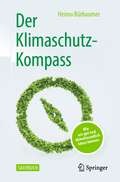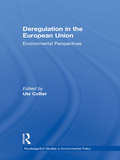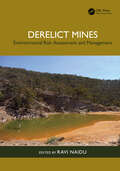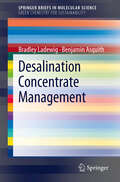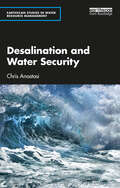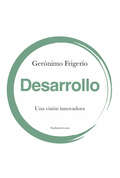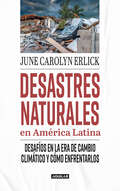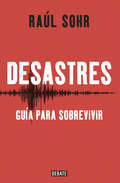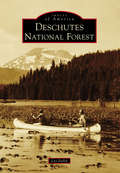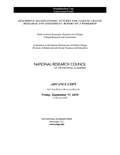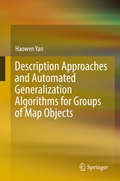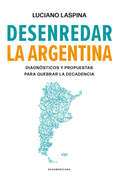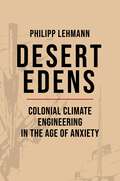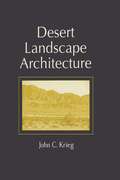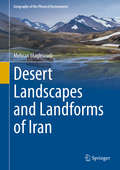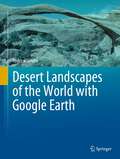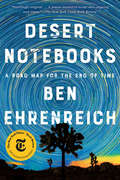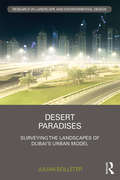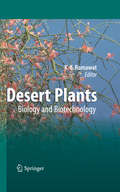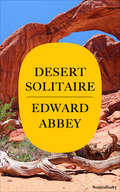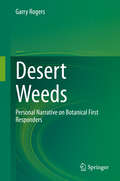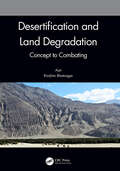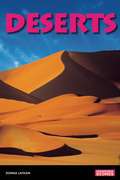- Table View
- List View
Der Klimaschutz-Kompass: Wie wir gut und klimafreundlich leben können
by Heimo BürbaumerWie können wir klimafreundlich leben? Sind Elektro- oder Hybrid-Autos effektiver? Sollte man regionale Lebensmittel kaufen oder Bio-Produkte? Wie mache ich mein Haus klimafit? Basierend auf dem aktuellen Stand der Energie- und Klimaschutzberatung beschreibt das Buch für alle Lebensbereiche – von der Mobilität über Wohnen bis zu Ernährung und Konsum – Maßnahmen, die je mindestens eine Tonne CO2 einsparen und dabei die Lebensqualität erhöhen. Dabei räumt der Autor mit gängigen Mythen wie der Gleichsetzung von Klimaschutz und Verzicht auf und gibt im Wirrwarr der Medienberichte vom Wasserstoffauto bis zur CO2-Kompensation Orientierung. Denn klimafreundlich leben bedeutet eine bewusste Entscheidung für fossilfreie Technologien und zukunftstaugliche Lebensweisen jetzt und nicht erst in ferner Zukunft. Das Buch richtet sich an alle, die klimafreundlich ihren Alltag meistern wollen, aber nicht wissen, wie dies effektiv und ohne Verzicht umsetzbar ist. Der Klimaschutz-Kompass gibt dazu eine einfach verständliche, wissenschaftlich begründete Anleitung, wie eine klimafreundliche Lebensweise alltagstauglich umsetzbar ist.
Der Kugelblitz: Eine moderne Analyse des ungelösten Problems der atmosphärischen Elektrizität
by Herbert BoernerKugelblitze sind rätselhaft. Diese leuchtenden Objekte, die gelegentlich während eines Gewitters auftreten und einen Durchmesser von mehreren Metern erreichen können, stellen die Wissenschaft seit etwa 200 Jahren vor Probleme. Trotz mehrerer Tausend gemeldeter Beobachtungen ist ihre physikalische Natur noch immer unbekannt. In diesem Buch werden gut dokumentierte Fälle von Kugelblitzen beschrieben und genutzt, um wichtige Aspekte dieser mysteriösen Form der atmosphärischen Elektrizität zu analysieren. Im Laufe des Buches erörtert der Autor die verschiedenen Facetten des Problems in einem zugänglichen, wissenschaftlich fundierten Text und liefert so einen lesbaren und informativen Bericht, der den neugierigen Leser fesseln wird. Die Analyse kulminiert in der überraschenden Schlussfolgerung, dass die Lösung dieses Rätsels vielleicht schon seit vielen Jahren vorliegt aber bisher nicht erkannt wurde.Ein Vorwort von Earle Williams, dem führenden Blitzforscher am MIT, leitet das Buch ein.
Deregulation in the European Union: Environmental Perspectives (Routledge/eui Studies In Environmental Policy Ser.)
by Ute CollierExamines the environmental implication of economic deregulation through case studies of the energy, transport and water sectors. The book deals with options for deregulation, looking at self-regulation, negotiated agreements and environmental management systems. Presenting evidence from a number of EU member states and Hungary, a likely contender f
Derelict Mines: Environmental Risk Assessment and Management
by Ravi NaiduMine areas left behind by companies that no longer exist are defined as derelict mines – those that were operated and closed at a time when most countries did not have adequate regulations requiring rehabilitation of the impacted mine areas. This book provides unique information on the extent and severity of derelict mines’ impact on environmental degradation and human and environmental health. It examines the nature of derelict mines, short-term and long-term risks to sensitive receptors, tools for monitoring and prioritizing risks, and technological advances for rehabilitation. This book considers a risk-based approach to managing derelict mines, which is reliable and cost-effective.FEATURES Provides fundamental information on derelict mines and their inventory in different countries Explains risk-based management of derelict mines and the importance of community perspectives as a reliable and cost-effective method Identifies ownership and liability issues through many case studies in Australia and other countries that must deal with the remediation of derelict mines Presents remediation, assessment, and predictive tools for managing pit lakes Helps readers set standards, regulatory measures, and policies related to mine closures This book is for engineers and professionals who work in mining, geology, chemistry, mineralogy, geotechnics, and hydrogeology and deal with industrial site management, waste management, mine closures, mine site reclamation, derelict mine remediation, and mine revegetation. It is also an insightful resource for graduate students, academics, and researchers focused on these courses.
Desalination Concentrate Management
by Bradley Ladewig Benjamin AsquithThis book examines five methods used for concentrate management, namely; disposal to surface water, disposal to sewerage, deep well injection, land applications and evaporation ponds. In particular, the book focuses on the design, siting, cost, and environmental impacts of these methods. While these methods are widely practiced in a variety of settings already, there are many limitations that restrict the use of certain disposal options in particular locations.
Desalination and Water Security (Earthscan Studies in Water Resource Management)
by Chris AnastasiDesalination is to the water industry what renewables are to the electricity sector. However, unlike renewables, the former is being deployed in a quiet revolution away from public glare. This book provides a holistic view of desalination, highlighting the important role this technology can play in providing safe access to water across the globe. It describes the context for this technology to flourish in the coming decades. It discusses the pressures on freshwater resources and the key role the desalination industry plays as it moves from a good-to-have provider today to a must-have mainstream water solution in the future. The book explores the vital elements of the desalination industry, including the winning technologies and how further technological developments will reduce costs and increase deployment into new areas. It also addresses the energy used and the key environmental issues of carbon dioxide emissions and brine waste production. Using a series of country case studies, the book illustrates how desalination can supplement natural water resources in different environments and for different purposes, and how it is supporting domestic and economic activity. Providing a forward-thinking assessment, the book considers developments over the next 30 years as climate change impacts become even more apparent. This book will be of great interest to those working to alleviate water scarcity and improve water security. It will also be of interest to those in water resource management, water policy and regulation, water science, and environmental engineering.
Desarrollo: Una visión innovadora
by Gerónimo Frigerio¿Por qué el desarrollo es el futuro de América Latina? Porque supone pasar de la pobreza a la generación de riqueza, de la informalidad a la formalidad y de una realidad de desempleo a una de creación de trabajo. Gerónimo Frigerio explica cómo en un libro realista y esperanzador. La ambición de este libro es servir de inspiración a hombres y mujeres de América Latina para que nos convirtamos en actores del desarrollo y, por lo tanto, en protagonistas de un futuro mejor en nuestros países y en la región. El proceso de desarrollo no solo implica pasar del estancamiento al crecimiento, de la pobreza a la generación de riqueza, de la informalidad a la formalidad, o de una realidad de desempleo a una de creación de trabajo; supone también convertir las trabas en oportunidades, la parálisis en acción, el desánimo en esperanza. Con la claridad y contundencia con que lo hizo en Simple. Una idea para transformar el futuro de América Latina, Gerónimo Frigerio combina visión individual, nacional y regional en un marco de reflexión realista, práctico y constructivo, y presenta un mensaje optimista: América Latina puede dejar de ser un conjunto de países sin rumbo para transformarse en un conjunto de sociedades que planifican su futuro.
Desastres naturales en América: Un llamado a la sobrevivencia del cambio climático
by June Carolyn Erlick"Mientras escribo este libro, leo los diarios y escucho las noticias, y siento como si todas las lecciones que he aprendido después de haber vivido e investigado sobre los desastres naturales y sus consecuencias estuvieran desplegándose en tiempo real". June Carolyn Erlick Los desastres naturales moldean la historia y la sociedad, y, a su vez, su impacto a largo plazo está determinado por la historia y la sociedad. Esto es especialmente cierto en América Latina y el Caribe, donde el cambio climático está aumentando la frecuencia e intensidad de estas calamidades. Desde las inundaciones precolombinas en los Andes, hasta la devastación del huracán María en Puerto Rico, pasando por las lecciones que dejaron eventos como el terremoto de México, la erupción del Nevado del Ruiz que arrasó Armero, la inundación de la amazonía brasileña y los huracanes en el Caribe, este libro demuestra que las consecuencias de las catástrofes naturales se multiplican cuando se conjugan con corrupción y desidia política. "Este libro es un examen impresionante de la forma en que las comu-nidades y los individuos luchan por sobrevivir a los desastres natura-les, cómo se adaptan a las consecuencias y llevan vidas que han sido transformadas por el dolor, la pérdida y el sufrimiento". Arthur Kleinman, profesor de Antropología Médica en Salud Global y Medicina Social, Universidad de Harvard, y autor de The Soul of Care
Desastres: Guia para sobrevivir
by Raúl SohrTerremotos, maremotos, erupciones volcánicas, aluviones, incendios forestales y otras calamidades azotan, con regularidad, a nuestro país Los fenómenos naturales destructivos han marcado la historia nacional a tal punto que, como menciona el autor, no falta quien dice que "nueve de cada diez desastres prefieren Chile". <P><P>El impacto de episodios recientes "como el terremoto de magnitud 8,8° ocurrido en febrero de 2010 o los megaincendios forestales que afectaron al centro y sur del país en enero de 2017" ha actualizado la urgencia por contar con planes de contingencia. El objetivo es enfrentar, de mejor modo, el impacto y el temor que los desastres de este tipo generan en la población.
Deschutes National Forest: Deschutes And Willamette National Forests, Oregon (Images of America)
by Les JoslinFrom the crest of the High Cascades eastward to the High Desert, the Deschutes National Forest is one of America’s great national treasures. Timber, water, and forage were plentiful in Central Oregon and provided the building blocks for the region. Today, the national forest’s scenery and year-round outdoor recreational resources play major roles in sustaining a vibrant and diverse modern economy and a unique way of life. Since 1905, these resources have been administered by the US Forest Service, fulfilling its mission to pursue “the greatest good of the greatest number in the long run,” as decreed by forester Gifford Pinchot when he led the fledgling agency.
Describing Socioeconomic Futures for Climate Change Research and Assessment: Report of a Workshop
by National Research Council of the National AcademiesThe implications of climate change for the environment and society depend on the rate and magnitude of climate change, but also on changes in technology, economics, lifestyles, and policy that will affect the capacity both for limiting and adapting to climate change. Describing Socioeconomic Futures for Climate Change Research and Assessment reviews the state of science for considering socioeconomic changes over long time frames and clarifies definitions and concepts to facilitate communication across research communities. The book also explores driving forces and key uncertainties that will affect impacts, adaptation, vulnerability and mitigation in the future. Furthermore, it considers research needs and the elements of a strategy for describing socioeconomic and environmental futures for climate change research and assessment. Describing Socioeconomic Futures for Climate Change Research and Assessment explores the current state of science in scenario development and application, asserting that while little attention has been given to preparing quantitative and narrative socioeconomic information, advances in computing capacity are making development of such probabilistic scenarios a reality. It also addresses a number of specific methodological challenges and opportunities and discusses opportunities for a next round of assessments.
Description Approaches and Automated Generalization Algorithms for Groups of Map Objects
by Haowen YanThis book focuses on the generalization of map features, providing descriptions and classifying groups of map objects into six categories: point clusters, groups of contours, road networks, river networks, continuous areal features and discrete areal features. Discussing the methods and algorithms in map generalization in equal measure, it also describes the approaches for describing map features. The book is a valuable reference for graduates and researchers who are interested in cartography and geographic information science/systems, especially those in automated map generalization and spatial databases construction.
Descriptive Taxonomy
by Mark F. Watson Chris H. C. Lyal Colin A. Pendry Mark F. Watson Chris H. C. LyalIn an age when biodiversity is being lost at an unprecedented rate, it is vital that floristic and faunistic information is up to date, reliable and easily accessible for the formulation of effective conservation strategies. Electronic data management and communication are transforming descriptive taxonomy radically, enhancing both the collection and dissemination of crucial data on biodiversity. This volume is written by scientists at the forefront of current developments of floras and faunas, along with specialists from applied user groups. The chapters review novel methods of research, development and dissemination, which aim to maximise the relevance and impact of data. Regional case studies are used to illustrate the outputs and impacts of taxonomic research. Integrated approaches are presented which have the capacity to accelerate the production of floras and faunas and to better serve the needs of a widening audience.
Desenredar la Argentina: Diagnósticos y propuestas para quebrar la decadencia
by Luciano LaspinaUna salida a las profundas heridas generadas por el populismo a través de medidas para no repetir los errores que llevaron a la actual decadencia. Diagnóstico de los principales problemas que enfrentará el próximo gobierno y reformas económicas orientadas a resolverlos. «El próximo gobierno asumirá en medio de la crisis terminal de un nuevo experimento populista en la Argentina. Nuestro país tiene una larguísima tradición de populismo político y macroeconómico. La economía argentina está totalmente enredada. Enredada en una maraña de complejas regulaciones, altos impuestos, trabas para importar, impuestos para exportar, insólitas restricciones y costos para crear empleos, desincentivos e inseguridad jurídica para invertir, dificultades crónicas para ahorrar sin ser estafado por la inflación e imposibilidad de obtener créditos a plazos y tasas razonables. Por eso, la economía tropieza con crisis y recesiones desde hace muchas décadas. El próximo gobierno deberá desenredar rápidamente la Argentina impulsando reformas valientes». Con firme decisión política y sólida argumentación técnica, Luciano Laspina propone Desenredar la Argentina marcando la salida de las profundas heridas generadas por el populismo, y presentando medidas para no repetir los errores que llevaron a la actual decadencia. Cada capítulo de esta obra elabora el diagnóstico de los principales problemas que enfrentará el próximo gobierno y expone las reformas económicas orientadas a resolverlos. El mensaje del libro es esperanzador: si al capital humano y los recursos naturales de nuestra tierra sumamos la determinación política de dejar atrás las recetas del pasado y avanzar hacia el desarrollo, lograremos el país grande y respetado que ansiamos.
Desert Edens: Colonial Climate Engineering in the Age of Anxiety (Histories of Economic Life #9)
by Philipp LehmannHow technological advances and colonial fears inspired utopian geoengineering projects during the late nineteenth and early twentieth centuries From the 1870s to the mid-twentieth century, European explorers, climatologists, colonial officials, and planners were avidly interested in large-scale projects that might actively alter the climate. Uncovering this history, Desert Edens looks at how arid environments and an increasing anxiety about climate in the colonial world shaped this upsurge in ideas about climate engineering. From notions about the transformation of deserts into forests to Nazi plans to influence the climates of war-torn areas, Philipp Lehmann puts the early climate change debate in its environmental, intellectual, and political context, and considers the ways this legacy reverberates in the present climate crisis.Lehmann examines some of the most ambitious climate-engineering projects to emerge in the late nineteenth and early twentieth centuries. Confronted with the Sahara in the 1870s, the French developed concepts for a flooding project that would lead to the creation of a man-made Sahara Sea. In the 1920s, German architect Herman Sörgel proposed damming the Mediterranean in order to geoengineer an Afro-European continent called &“Atlantropa,&” which would fit the needs of European settlers. Nazi designs were formulated to counteract the desertification of Eastern Europe and Central Asia. Despite ideological and technical differences, these projects all incorporated and developed climate change theories and vocabulary. They also combined expressions of an extreme environmental pessimism with a powerful technological optimism that continue to shape the contemporary moment.Focusing on the intellectual roots, intended effects, and impact of early measures to modify the climate, Desert Edens investigates how the technological imagination can be inspired by pressing fears about the environment and civilization.
Desert Landscape Architecture
by John C. KriegThis book provides an understanding of desert environments, their climatic conditions, and unique physical beauty - using the five American deserts of the southwestern United States as an example. Through considerable research, sensitivity, and practical experience, the author provides insight into how built environments are designed and installed in order to cope with the harsh, unforgiving physiographic area. Bridging the gap between professional jargon and common sense, Desert Landscape Architecture displays detailed information for every facet of landscape design, environmental concerns, water issues, cultural issues, and plant material use.This unique, thorough book: Provides information applicable to any desert region of the world Supplies a plant compendium with extensive plant lists comprising more than 750 species Examines desert flora and fauna as well as the fragile ecosystems they occupy Reviews human use areas Investigates grading from an aesthetic and practical standpoint Explains the significance of adequate site drainage Discusses schematic, preliminary, and working drawing plans Lists types of site furnishings and their specific purposes Describes how various hardscape elements are drawn and specified Explains plant growth in detail Discusses the dynamics of plant communities and their function in larger ecosystems Reviews the factors affecting plant selection in the design process Identifies desert planning zones Emphasizes the critical nature of irrigation design in the desert landscape architecture - explaining it as an environmental necessity, not a technical issue Outlines the basic principles of hydrology related to system design Discusses water conservation and presents alternatives for reducing water consumption Examines types of light and sun
Desert Landscapes and Landforms of Iran (Geography of the Physical Environment)
by Mehran MaghsoudiThis book offers a unique and highly illustrated overview of the desert geomorphology of Iran. It describes the different landscapes and landforms of desert areas such as ergs and badlands offering a comprehensive insight into typical fluvial and eolian forms such as playas, alluvial fans, yardangs, salt domes, dunes, hoodoos and many more. The monograph elaborates the interaction of humans with the landscapes and discusses ongoing developments in geotourism, natural heritage sites as well as the potential for geoparks. Desert Landscapes and Landforms of Iran contains many photographs, satellite images, high-resolution aerial photos, maps, charts and tables which build a nice framework for the assessment of the different geomorphological features. It constitutes a comprehensive introduction for researchers and students of many disciplines in the fields of geography, geosciences, tourism and leisure studies, environmental sciences and landscape planning interested in typical physical characteristics of desert landscapes.
Desert Landscapes of the World with Google Earth
by Andrew GoudieThis book presents an introduction to desert landscapes—primarily landforms that are natural and man-made. It is based around the presentation of a series of beautiful and informative annotated Google Earth images. These are accompanied by text that describes the feature(s) concerned, their location, and their origin. There are also, in some cases, ground images taken by the author.
Desert Notebooks: A Road Map for the End of Time
by Ben EhrenreichLayering climate science, mythologies, nature writing, and personal experiences, this New York Times Notable Book presents a stunning reckoning with our current moment and with the literal and figurative end of time.Desert Notebooks examines how the unprecedented pace of destruction to our environment and an increasingly unstable geopolitical landscape have led us to the brink of a calamity greater than any humankind has confronted before. As inhabitants of the Anthropocene, what might some of our own histories tell us about how to confront apocalypse? And how might the geologies and ecologies of desert spaces inform how we see and act toward time—the pasts we have erased and paved over, this anxious present, the future we have no choice but to build? Ehrenreich draws on the stark grandeur of the desert to ask how we might reckon with the uncertainty that surrounds us and fight off the crises that have already begun.In the canyons and oases of the Mojave and in Las Vegas&’s neon apocalypse, Ehrenreich finds beauty, and even hope, surging up in the most unlikely places, from the most barren rocks, and the apparent emptiness of the sky. Desert Notebooks is a vital and necessary chronicle of our past and our present—unflinching, urgent—yet timeless and profound.
Desert Paradises: Surveying the Landscapes of Dubai’s Urban Model (Routledge Research in Landscape and Environmental Design)
by Julian BolleterDesert Paradises: Surveying the Landscapes of Dubai’s Urban Model explores how designed landscapes can play a vital role in constructing a city’s global image and legitimizing its socio-political hierarchy. Using the case study of Dubai, Bolleter explores how Dubai’s rulers employ a paradisiacal image of greening the desert, in part, as a tool for political legitimization. Bolleter also evaluates the designed landscapes of Dubai against the principles of the United Nations and the International Federation of Landscape Architects and argues that what is happening in Dubai represents a significant discrepancy between theory and practice. This book offers a new perspective on landscape design that has until now been unexplored. It would be beneficial to academics and students of geography, landscape architecture, urban design and urban planning – particularly those with an interest in Dubai or the many cities in the region that are experiencing Dubaiification.
Desert Plants
by Kishan Gopal RamawatVast areas of Earth's landmass exist as deserts, representing quite distinct ecosystems. Desert plants and animals have evolved specialised survival strategies to cope with the harsh environment of high temperatures and scarce water resources. The life-supporting vegetation of deserts is characterised by its unique reproductive biology, metabolism and adaptive characters. Plants like Prosopis cineraria and date palm form the basis of the rural economy in many countries, and are of great cultural importance; Jojoba and Jatropha have attracted interest as non-conventional sources of industrial oil and biodiesel. This book includes chapters on the seed biology, reproduction, mycorrhizae, stress physiology, and metabolism of desert plants, and describes current biotechnological approaches to their cultivation. It will be useful to researchers, teachers and students in the fields of plant sciences, agriculture, and forestry, and those involved in the management and conservation of desert ecosystems.
Desert Solitaire: A Season In The Wilderness
by Edward AbbeyThis memoir of life in the American desert by the author of The Monkey Wrench Gang is a nature writing classic on par with Rachel Carson&’s Silent Spring. In Desert Solitaire, Edward Abbey recounts his many escapades, adventures, and epiphanies as an Arches National Park ranger outside Moab, Utah. Brimming with arresting insights, impassioned arguments for wilderness conservation, and a raconteur&’s wit, it is one of Abbey&’s most critically acclaimed works. Through stories and philosophical musings, Abbey reflects on the condition of our remaining wilderness, the future of a civilization, and his own internal struggle with morality. As the world continues its rapid development, Abbey&’s cry to maintain the natural beauty of the West remains just as relevant today as when this book first appeared in 1968.
Desert Weeds: Personal Narrative on Botanical First Responders
by Garry RogersIn their rapid colonization of soil exposed by fires, floods, and grazing animals, weeds resemble the human specialists we label Emergency Medical Technicians (EMTs). Weeds are the first responders when disasters occur in nature. They occupy bare soil and prevent erosion by wind and water. In extreme cases such as a landslide, weeds are essential to the healing processes that replace the lost soil. Like a Band-Aid on a skinned knee, weeds protect the land while it recovers. Besides protecting the soil after disaster, weeds provide food for wildlife, and some of them provide food and medicine for people. Able to withstand harsh conditions, weeds will proliferate as global warming and other human impacts intensify. Thus, nature’s EMTs will increase while all other plants decline. The book provides a succinct definition of weeds according to their form and function in ecosystem processes. The narrative uses a representative set of weed species from a desert location to illustrate the full range of weed characteristics.
Desertification and Land Degradation: Concept to Combating
by Ajai Rimjhim BhatnagarDesertification and land degradation are complex phenomena, and we need to understand their causes, consequences, and means to mitigate and combat their impact. Therefore, this book aims to explain the concept and characteristics of drylands, desert and desertification, land degradation, wastelands, and the concept of ecosystem services. It also discusses various types of processes of land degradations, their characteristics, physics and indicators along with mapping, monitoring and assessment of methods involved. Concept of Ocean Biological Deserts is discussed along with international and regional efforts towards combating land degradation and desertification. Key Features:• Provides all the aspect of desertification and land degradation at one place • Includes comprehensive methods to monitor different desertification/land degradation processes • Comprehensive overview of the mapping, monitoring and modelling techniques • Role of space borne data in identifying, monitoring and combating desertification is evaluated and reported with real case studies • Explains the concept of ocean biological deserts, their characteristics and mapping
Deserts
by Donna LathamInvestigating the planet's biomes and examining the modern threats to each ecosystem, this interactive series challenges young readers to look at how their own actions influence the planet's health. With compare-and-contrast facts and vocabulary-building sidebars, each engaging guide reveals how environmental threats-both human and natural-affect plants and animals. Examining this growing biome, this guide shows that the desert is more than just a giant sandbox. Discussing desertification and how environmental change-such as ranching, overdevelopment, and cactus collection-in this area can threaten life outside the desert, this resource instructs students on the need to treat the desert with care.
